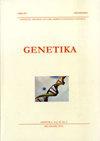伊朗-高加索生态地理群土耳其杏新遗传资源评价
4区 农林科学
Q3 Agricultural and Biological Sciences
引用次数: 0
摘要
采用主成分分析法对86个杏品种的19个性状和伊朗-高加索生态地理类群的基因型进行了评价。确定了杏各基因型在形态、物候和果实品质性状上的高变异性和差异性。各基因型的果实大小普遍为极小(9.3%)或极小(43.0%),大、特大果实基因型的总比例仅为16.3%。数据表明,90.1%的基因型磨碎果色为黄色,88.4%的基因型果仁甜,65%的基因型果硬度为5 kg/cm2。大约一半的杏基因型具有20%或高的总可溶性固形物含量。大多数基因型(67.3%)在季中收获,其他基因型(23.3%)在早期收获,4.7%的基因型收获很晚,3.5%的基因型收获较晚。只有一个基因型(1.2%)很早就收获。果实大小与果重、果核重、果肉/果核率高度相关。果皮颜色与果肉颜色之间也存在同样的相关性。可溶性固形物总量与果肉硬度和种子口感呈中等相关。主成分分析结果表明,前三个主成分占总变异的55%,分别为22.9%、19.8%和12.3%。品种间性状差异较大,大部分基因型均具有较高的可溶性固形物和较低的可滴定酸度,为今后选育提高相关性状提供了有利条件。本文章由计算机程序翻译,如有差异,请以英文原文为准。
Evaluation of new Turkish apricot genetic resources from the Irano-Caucasian eco-geographical group
This study presents 19 characters of 86 apricot cultivars and genotypes of the Irano- Caucasian eco-geographical group evaluated using principal component analysis. The high variability and differences among the apricot genotypes in terms of morphological, phenological and fruit quality traits were defined. The fruit size of the genotypes was generally very small (9.3 %) or small (43.0 %), the total rate of big and very big fruit genotypes was only 16.3%. The data showed that 90.1 % of the genotypes had yellow ground fruit colour, 88.4% had sweet kernel and 65% had firmness ?5 kg/cm2. About half of the apricot genotypes have 20% or high total soluble solids content. Most of the genotypes (67.3%) were harvested in mid-season and other genotypes (23.3%) were harvested early, while 4.7% of them were harvested very late, 3.5 % of the genotypes late. Only one genotype (1.2%) was harvested very early. The fruit size was highly correlated with fruit weight, pit weight and fruit flesh/pit rate. The same correlation was also observed between the fruit ground colour and fruit flesh colour. On the other hand, the total soluble solids were moderately correlated with fruit flesh firmness and seed taste. The results of the principal component analysis show that the 55% of the total variation is represented for the first three main components (22.9, 19.8, and 12.3%, respectively). The germplasm presented a large variation in the evaluated characters and most of the genotypes were found having high total soluble solids and low titratable acidity which would be beneficial for future breeding programs held to improve the related characters.
求助全文
通过发布文献求助,成功后即可免费获取论文全文。
去求助
来源期刊

Genetika-Belgrade
AGRONOMY-GENETICS & HEREDITY
CiteScore
1.80
自引率
0.00%
发文量
1
审稿时长
6-12 weeks
期刊介绍:
The GENETIKA is dedicated to genetic studies of all organisms including genetics of microorganisms, plant genetics, animal genetics, human genetics, molecular genetics, genomics, functional genomics, plant and animal breeding, population and evolutionary genetics, mutagenesis and genotoxicology and biotechnology.
 求助内容:
求助内容: 应助结果提醒方式:
应助结果提醒方式:


